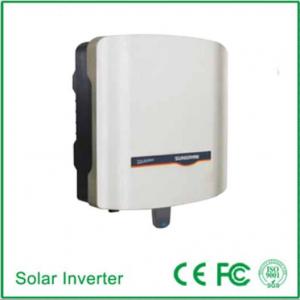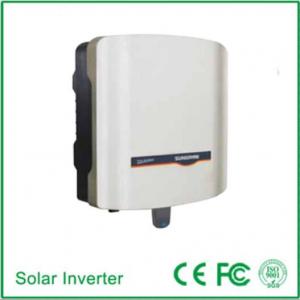Photovoltaic Grid-Connected Inverter SG4KTL-S
- Loading Port:
- China Main Port
- Payment Terms:
- TT or LC
- Min Order Qty:
- 50000 unit
- Supply Capability:
- 3000000 unit/month
OKorder Service Pledge
OKorder Financial Service
You Might Also Like
1. Structure of Photovoltaic Grid-Connected Inverter SG4KTL-S Description
A solar inverter, or PV inverter, or Solar converter, converts the variable direct current (DC) output of a photovoltaic (PV) solar panel into
autility frequency alternating current (AC) that can be fed into a commercial electrical grid or used by a local, off-grid electrical network.
It is acritical BOS–component in a photovoltaic system, allowing the use of ordinary AC-powered equipment. Solar inverters have
special functions adapted for use with photovoltaic arrays, including maximum power point tracking and anti-islanding protection.
Suitable for 50Hz/60Hz grid, could be used in Asia, Africa and Europe. Available for hand installation, no need for lifting machinery
assistance.
2. Main Features of the Photovoltaic Grid-Connected Inverter SG4KTL-S
• Max. input voltage 600V, compatible with different PV panel and string design
• Only 9kg, easy for handling and installation
• Max. Efficiency at 98.0%
• Ultra-quiet, suitable for residential use
• Access to home WiFi system, easy to enjoy the online monitoring
• Wireless communication design, intelligent mobile phone local and remote monitoring
• Product certification: TÜV, CE, AS4777, AS/NZS 3100, VDE AR N 4105
• Manufacturer certification: ISO 9001, ISO 14001, OHSAS 18000
3. Photovoltaic Grid-Connected Inverter SG4KTL-S Images


4. Photovoltaic Grid-Connected Inverter SG4KTL-S Specification
Input Side Data | |
| Max. PV input power | 4300W |
| Max. PV input voltage | 600V |
| Startup voltage | 150V |
| Nominal input voltage | 345V |
| MPP voltage range | 125~560V |
| MPP voltage range for nominal power | 240~520V |
| No. of MPPTs | 1 |
| Max. number of PV strings per MPPT | 2 |
| Max. PV input current | 18A |
| Max. current for input connector | 20A |
| Output Side Data | |
| Nominal AC output power | 4000W |
| Max AC output power(PF=1) | 4210W |
| Max. AC output apparent power | 4210VA |
| Max. AC output current | 18.3A |
| Nominal AC voltage | 230Vac (Single phase) |
| AC voltage range | 180~276Vac (May vary as per corresponding country’s grid standard) |
| Nominal grid frequency | 50Hz/60Hz |
| Grid frequency range | 45~55Hz/55~65Hz (May vary as per corresponding country’s grid standard) |
| THD | < 3 % (Nominal power) |
| DC current injection | <0.5 %In |
| Power factor | >0.99@default value at nominal power, (adj. 0.8 overexited~0.8 underexcited) |
| Protection | |
| Anti-islanding protection | YES |
| LVRT | NO |
| DC reverse connection protection | YES |
| AC short circuit protection | YES |
| Leakage current protection | YES |
| DC switch | Optional |
| DC fuse | NO |
| Overvoltage protection | Varistors |
| System Data | |
| Max. efficiency | 98.00% |
| Max. European efficiency | 97.50% |
| Isolation method | Transformerless |
| Ingress protection rating | IP65 |
| Night power consumption | <1W |
| Operating ambient temperature range | -25~60℃ (>45℃ derating) |
| Allowable relative humidity range | 0~100% |
| Cooling method | Natural cooling |
| Max. operating altitude | 4000m (>2000m derating) |
| Display | LED, LCD(optional) |
| Communication | WiFi (optional) |
| DC connection type | MC4 |
| AC connection type | Plug and play connector |
| Certification | IEC61000-6-2,IEC61000-6-3, |
| AS/NZS3100,AS4777.2,AS4777.3 | |
| VDE-AR-N-4105, VDE0126-1-1,CE,G83/2,C10/11,EN50438,CGC | |
| Mechanical Data | |
| Dimensions(W×H×D) | 300*370*125 mm |
| Mounting method | Wall bracket |
| Weight | 9kg |
5. FAQ of Photovoltaic Grid-Connected Inverter SG4KTL-S
Q1:Which payment terms can you accept?
A1:T/T,L/C,Moneygram,Paypal are available for us.
Q2:Can we visit your factory?
A2:Sure,welcome at any time,seeing is believing.
- Q:Can a solar inverter be used with building-integrated photovoltaics (BIPV)?
- Yes, a solar inverter can be used with building-integrated photovoltaics (BIPV). In fact, a solar inverter is an essential component of any BIPV system as it converts the direct current (DC) generated by the BIPV panels into alternating current (AC) that can be used to power electrical devices in a building or fed back into the grid.
- Q:What is the maximum power output of a solar inverter?
- The maximum power output of a solar inverter can vary depending on its size and model. Generally, residential solar inverters have a power output ranging from 2 kilowatts (kW) to 10 kW, while commercial and utility-scale inverters can have power outputs exceeding 1 megawatt (MW).
- Q:What is the maximum DC input current of a solar inverter?
- The maximum DC input current of a solar inverter can vary depending on the specific model and its design. However, in general, the maximum DC input current of a solar inverter is determined by its capacity and is usually specified by the manufacturer.
- Q:What is the role of a solar inverter in preventing underperformance?
- The role of a solar inverter in preventing underperformance is to convert the direct current (DC) produced by solar panels into alternating current (AC) that can be used to power electrical devices. It ensures optimal performance by tracking the maximum power point of the solar panels, regulating voltage and current levels, and protecting against voltage fluctuations or grid disturbances. This helps to minimize energy losses, enhance system efficiency, and prevent underperformance by ensuring that the solar system operates at its maximum capacity.
- Q:Can a solar inverter be installed indoors or outdoors?
- A solar inverter can be installed both indoors and outdoors, depending on the specific requirements and preferences of the installation. However, it is essential to consider factors such as available space, ventilation, temperature regulation, and protection from environmental elements when deciding on the installation location.
- Q:Can a solar inverter be used with different grid voltages or frequencies?
- No, a solar inverter cannot be used with different grid voltages or frequencies. Solar inverters are designed to convert the DC power generated by solar panels into AC power that matches the specific grid voltage and frequency of the electrical grid it is connected to. Using a solar inverter with different grid voltages or frequencies can cause damage to the inverter and may result in a loss of efficiency or functionality.
- Q:How does a solar inverter handle reverse power flow?
- A solar inverter handles reverse power flow by automatically detecting the excess power generated by the solar panels and converting it into usable AC power for the electrical grid. It is designed to seamlessly switch between supplying power to the grid and receiving power from it, ensuring efficient utilization of solar energy while maintaining grid stability.
- Q:Can a solar inverter be connected to a smartphone app for monitoring?
- Yes, a solar inverter can be connected to a smartphone app for monitoring. Many modern solar inverters have built-in Wi-Fi or Bluetooth capabilities that allow them to connect to a smartphone app. This app provides real-time monitoring of the solar system's performance, including energy production, consumption, and any potential issues or faults. It also allows users to remotely control and adjust settings of the inverter for optimized energy management.
- Q:What is the maximum voltage input for a solar inverter?
- The maximum voltage input for a solar inverter typically depends on the specific model and manufacturer. However, in general, it ranges from around 600 to 1000 volts, with some higher-end models able to handle higher voltages.
- Q:Are there any maintenance requirements for a solar inverter?
- Yes, there are maintenance requirements for a solar inverter. Regular inspections, cleaning, and monitoring of the inverter's performance are necessary to ensure it operates efficiently and effectively. Additionally, components like capacitors and fans may require replacement over time. Following manufacturer guidelines and seeking professional assistance when needed can help extend the lifespan and performance of the solar inverter.
1. Manufacturer Overview |
|
|---|---|
| Location | |
| Year Established | |
| Annual Output Value | |
| Main Markets | |
| Company Certifications | |
2. Manufacturer Certificates |
|
|---|---|
| a) Certification Name | |
| Range | |
| Reference | |
| Validity Period | |
3. Manufacturer Capability |
|
|---|---|
| a)Trade Capacity | |
| Nearest Port | |
| Export Percentage | |
| No.of Employees in Trade Department | |
| Language Spoken: | |
| b)Factory Information | |
| Factory Size: | |
| No. of Production Lines | |
| Contract Manufacturing | |
| Product Price Range | |
Send your message to us
Photovoltaic Grid-Connected Inverter SG4KTL-S
- Loading Port:
- China Main Port
- Payment Terms:
- TT or LC
- Min Order Qty:
- 50000 unit
- Supply Capability:
- 3000000 unit/month
OKorder Service Pledge
OKorder Financial Service
Similar products
New products
Hot products
Related keywords






























